On arrival at Windoek's International Airport once you have cleared immigration and customs, you are met by a representative who will assist with your luggage to the transfer vehicle. Transfer by road to Galton House for your self drive briefing (including maps), your rental vehicle will also be delivered to you here.
Spend one night at Galton House including breakfast.
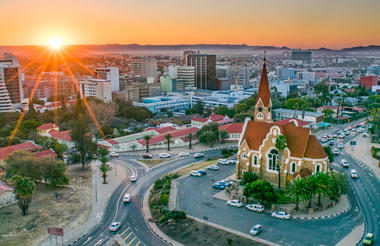
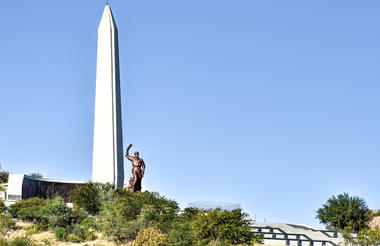
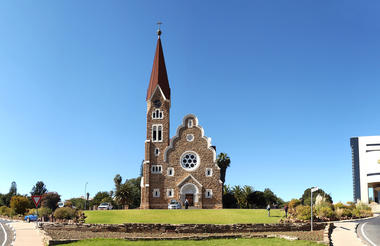
After breakfast you depart Windhoek in your rental vehicle and drive onwards to arrive at Hoodia Desert Lodge. We recommend a stop at a local store to stock up on some water, drinks and snacks for the road. Arrive in the afternoon for check in and lunch. The afternoon is as leisure and we recommend a guided sundowner drive with Hoodia on their property.
Spend two nights at Hoodia Desert Lodge including all meals.
Spend the next couple of days exploring the remarkable sights of the Namib Desert.
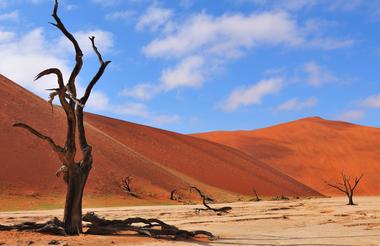
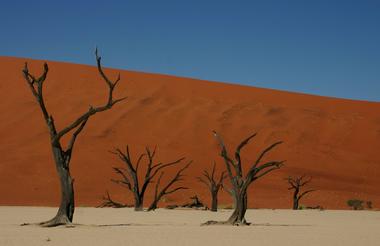
Sundowner drive at Hoodia Desert Lodge
This morning you will need to rise early for a captivating guided Sossusvlei excursion as arranged with Hoodia Desert Lodge. Enter the park at sunrise and capture the dunes whilst the light is soft and shadows accentuate the towering shapes and curves. This area boasts some of the highest free standing and dunes in the world and your guide will give you an insight on the formation of the Namib Desert and its myriad of fascinating creatures and plants that have adapted to survive these harsh environs.
Once you have explored Sossusvlei, Deadvlei and surrounding dune fields to your heart’s content you can enjoy a relaxed picnic brunch in the shade of a camel thorn tree. You then return to Hoodia Desert Lodge in the early afternoon, with the rest of the afternoon at your leisure (from experience, this is usually welcomed after an exhilarating morning in the dunes)
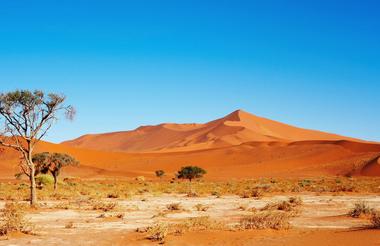
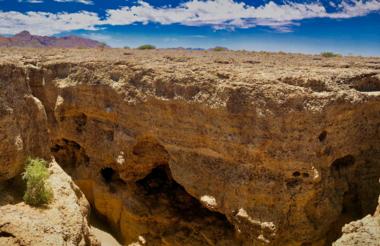
The fascinating drive to Swakomund today takes you northwest through awesome and ever changing desert landscapes of the Namib Naukluft National Park, including the impressive Gaub and Kuiseb canyons. You will meet the coast at the port town of Walvis Bay, where you have the option to visit the lagoon to see the interesting mix of pelicans, flamingos and other sea birds, before continuing north to Swakopmund where you can enjoy the pleasant seaside location and cooler coastal air. This afternoon you have the option to explore the shops, waterfront and craft market as appeals, before heading out for dinner at one of the popular restaurants in town. Dinner this evening is for your own account as there are a number of excellent restaurants to choose from.
Spend two nights at Cornerstone Guesthouse including breakfast.
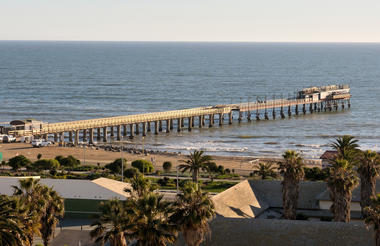
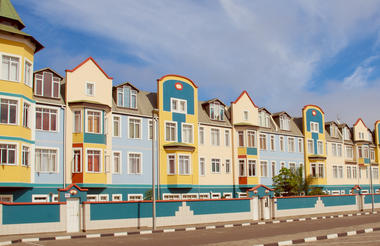
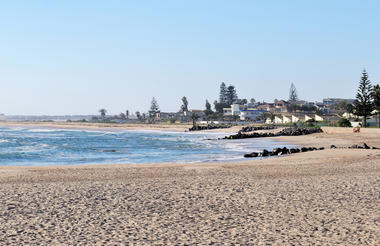
Today would be perfect if you wanted to enjoy an optional sunrise balloon flight or scenic light aircraft flight over the Namib Naukluft National Park before you depart for Swakopmund (optional extra at additional cost).
We recommend that you avoid a stay in Swakopmund over a weekend, as most shops close by Saturday afternoon and only a select few open on a Sunday. Restaurants will be open and tours will be on offer in the morning over weekends.
Today is at your leisure to spend exploring Swakopmund, Walvis Bay and surrounding areas. You may like to climb the coastal dunes at Langstrand or Dune 7, explore Swakopmund’s shops, cafe's, museums and waterfront, or partake in any of the adventure activities on offer such as sand-boarding, boat cruises, kayaking, and scenic flights (all at extra cost). We recommend joining a morning dolphin and seal catamaran cruise on the Walvis Bay harbour and lagoon this morning, where you will see seals, pelicans, and flamingos amongst other marine life,and hopefully you will also see Heaviside and Bottlenose dolphins. Oysters and South African bubbly are served on board, along with other beverages and snacks. Another option would be to explore the desert area by taking part in the fascinating and informative “Living Desert Tour”. This Desert Tour concentrates on exploring the local dune belt between Walvis Bay and Swakopmund, taking special care not to damage the gravel plains and cause any unnecessary damage to the dune eco-system. Also highly recommended is a half or full day excursion into Sandwich Harbour, the most important wetlands and feeding area on west coast of Southern Africa for many migratory birds.
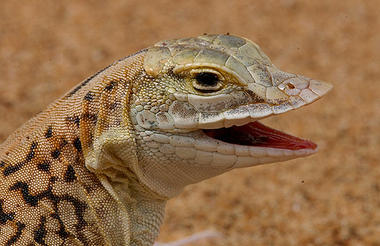
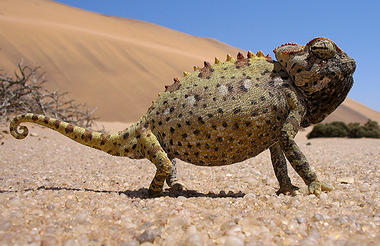
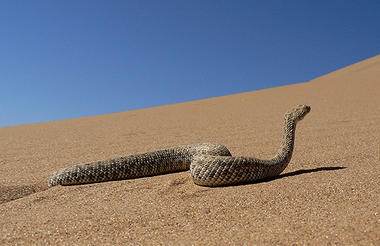
Today you continue your self-drive journey, passing Namibia’s highest mountain, the Brandberg which peaks at 2,573 m above sea level, and take time to view game and absorb the vastness of the scenery along the way. Damaraland is typified by displays of colour, magnificent table topped mountains, rock formations and bizarre-looking vegetation. The present day landscape has been formed by the erosion of wind, water and geological forces which have formed rolling hills, dunes, gravel plains and ancient river terraces. It is the variety and loneliness of the area as well as the scenic splendour which will reward and astound you, giving one an authentic understanding of the word 'wilderness'. You arrive at the Mowani Mountain Camp where you are staying for the next two nights. If you arrive on time, you can join a scheduled afternoon activity to visit the nearby attractions and geological sites of the pre-historic Twyfelfontein rock engravings (recently declared a UNESCO World Heritage Site)if not there is the option to do this tour the following afternoon.
Spend two nights at Mowani Mountain Camp including all meals and two daily scheduled activities.
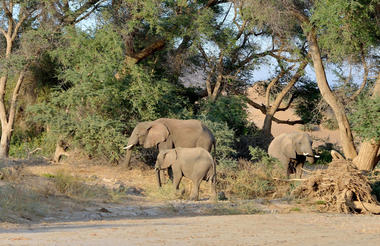
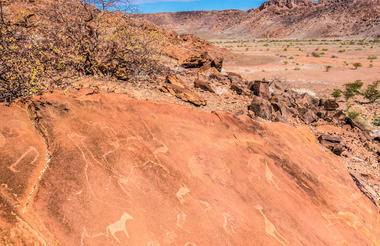
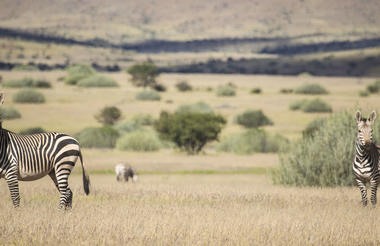
Today you joinon a scheduled morning activity, which departs after an early breakfast into the ephemeral Aba Huab River valley to explore this remarkable region and to search for game, especially the elusive desert adapted elephants if they are in the area. Damaraland is home to a variety of desert adapted wildlife and hidden desert treasures. You will then return to camp for lunch and a well-deserved siesta and enjoy an afternoon activity as on offer at Mowani.
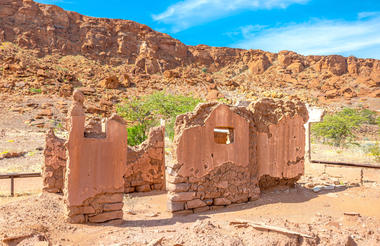
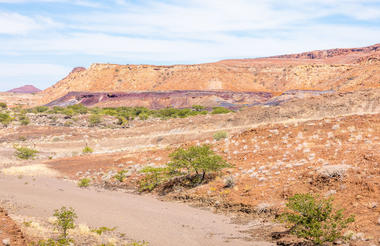
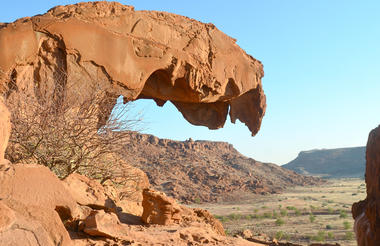
Desert Adapted Elephant:
In habitats with sufficient vegetation and water an adult elephant consumes as much as 300 kg of roughage and 230 litres of water every day of its life. Consider what a herd of them would eat and drink in a week or a month or a year. Finding an African elephant in a desert? Well, yes and not only elephant, but other large mammals as well, such as black rhinoceros and giraffe. Their ranges extend from river catchments in northern Kaokoveld as far south as the northern Namib. Apart from the Kunene River, seven river courses northwards from the Ugab provide them with possible routes across the desert, right to the Skeleton Coast. The biggest are the Hoarusib, the Hoanib, the Huab and the Ugab Rivers. Desert adapted elephant in Kaokoland and the Namib walk further for water and fodder than any other elephant in Africa. The distances between waterholes and feeding grounds can be as great as 68 km. The typical home range of a family herd is larger than 2,000km², or eight times as big as ranges in central Africa where rainfall is much higher. They walk and feed at night and rest during the day. To meet their nutritional and bulk requirements they browse on no fewer than 74 of the 103 plant species that grow in their range. Not a separate species or even a subspecies, they are an ecotype unique to Namibia in Africa south of the equator, behaviourally adapted to hyper-arid conditions. Elephant in Mali on the southwestern fringe of the Sahara Desert are the only others known to survive in similar conditions.
Today you continue on your self-drive safari and drive to southern Etosha to the Andersson’sCamp.Andersson’s Camp also boasts two very productive floodlit waterholes, which are renowned to be very lively during the day and at night (in view from the dining room). Especially exciting is the underground hide to enjoy a different view point of the animals frequenting the waterhole.
Spend one night at Andersson's Camp including dinner and breakfast.



Andersson's Camp - Night drives
Today you enter the Etosha National Park (gates open sunrise) and explore and stop over at the various waterholes in the hope of experiencing some exciting wildlife sightings. You can have lunch (for own account) at any of the rest camps inside the park.
After your arrival at Onguma the rest of the day is spent at your leisure (very often this is welcomed since you have spent most of the day in the vehicle game driving in the park).
Spend two nights at Onguma Tented Camp including dinner and breakfast
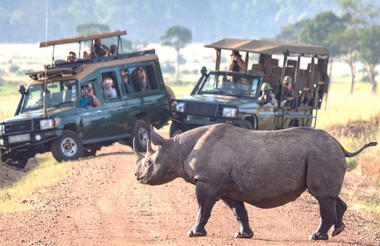

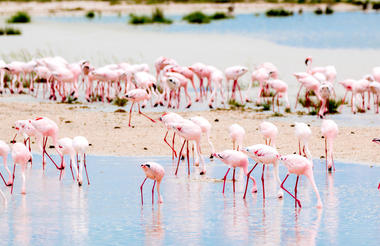
Please note:
Etosha National Park gates open at sunrise and close at sunset (including the camp gates). The camps have a small shop for
basic supplies, a fuel station, and a post office.
The speed limit whilst driving in Etosha is 60km per hour.
Do not get out of your vehicle whilst in Etosha unless you are safely within a designated area.
The daily entrance fee for Etosha National Park (payable at Dolomite, Okaukuejo, Halali or Namutoni reception by cash or credit card) is N$80 per person and N$10 for the vehicle. You will fill in a registration form upon entry into Etosha, please keep this as well as your park fees payment receipt to present at the gate upon departure.
Today is available for you to have time to relax in lovely comfortable surroundings while still giving time to be spent game viewing in the National Park as much as appealsin your own rental vehicle, within park regulations. Onguma also offers a choice of additional activities you can book and pay direct, including a sundowner drive on the Onguma Reserve


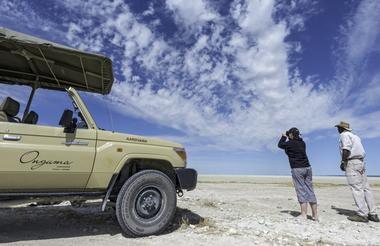
After breakfast and freshening up you will depart for and make your way to Okonjima located at the base of the Omboroko Mountains near Waterberg. You will arrive at Okonjima Bush Camp in time for lunch. Here you can enjoy the welcoming atmosphere, superb accommodation and fantastic activities; starting with a guided afternoon excursion.
Spend two nights at Okonjima Luxury Bush Camp on a fully inclusive basis.



Large Carnivore tracking on foot
Bushman Trail
Nature Drives
Bird Watching
Nature Trails
The AfriCat Foundation
The Cheetah Project
A full day of wonderful activities as offered by Okonjima. You will rise early and have tea/coffee and a snack before departing on the morning guided activity. Return to camp for a hearty brunch with time to relax and enjoy your peaceful bush surroundings until the afternoon guided activity commences.
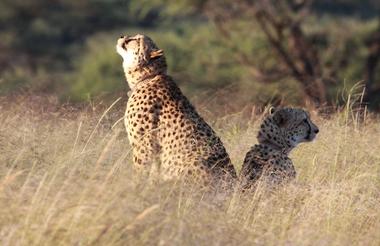

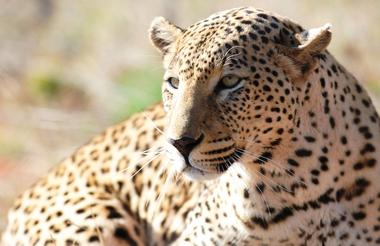
You will rise early this morning for another memorable guided activity before you return to Bush Camp for a sumptuous breakfast. After freshening up you will depart for Windhoek in the late morning, via the town of Okahandja, to arrive back in Windhoek in the mid afternoon. If time allows, you will have the option to visit the Woodcarvers Craft Market in Okahandja for some last minute curio shopping before continuing on to Windhoek. Upon your arrival in Windhoek you return your rental vehicle in time for your ongoing international departure flight.





